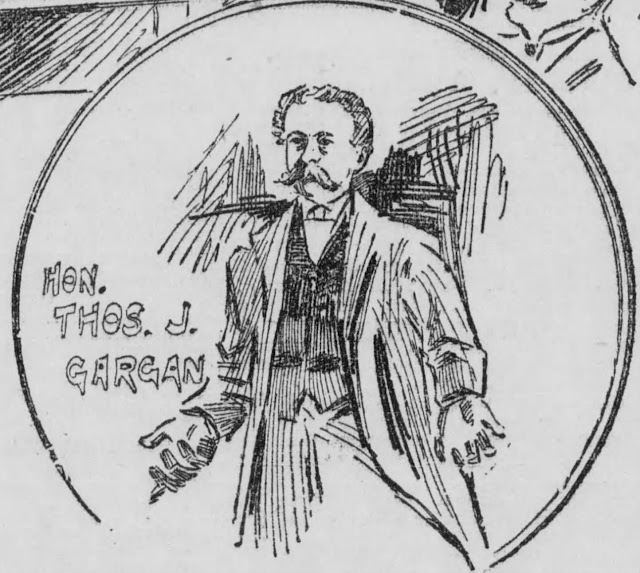American Irish Historical Society was formed in Boston on January 20, 1897, to Promote a Positive Image of the Irish in America
On January 20, 1897, a group of 40 distinguished Irish-Americans met at the Old Revere House in Boston to officially launch the American Irish Historical Society.
Among the elected officers were Rear Admiral Richard W. Meade; newspaper editor Thomas Hamilton Murray; Theodore Roosevelt, who claimed Irish ancestry on his mother’s side; sculptor Augustus St. Gaudens, who was born in Dublin to an Irish mother and French father; poet and writer James Jeffrey Roche, who wrote the biography of John Boyle O’Reilly; Thomas Lawlor of the publishing company Ginn and Company and Thomas Addis Emmett, a prominent New York attorney and part of an illustrious patriotic family.
Thomas J. Gargan, a distinguished Boston orator and writer, presided at the first AIHS meeting.
The group’s lofty mission was to “correct the erroneous, distorted and false views of history in relation to the Irish in America; to encourage and assist in the formation of local societies; and to promote and foster an honorable national spirit of patriotism.”
Part of the impetus for the group coming together had to do with an ongoing prejudice that many Americans had about the Irish in America. Even as the Irish continued to succeed in politics,, business, culture, sports and the arts, a new round of anti-Irish, anti-Catholic attacks continued to disparage the Irish and their contributions to the United States. This assault was propelled by organizations such as the American Protective Association, and locally, a rabid publication called the British American Citizen newspaper, which screamed regular headlines about the Irish being “Ignorant, Narrow-minded and Rude.”
Additionally, the AIHS was increasingly frustrated by an organization called the Scotch Irish Society, which asserted that the Irish contributions to the American Revolution were largely Protestant Ulster Scots from the north of Ireland, who had settled in Ireland but considered themselves Scottish.
To counter these attacks, a group of New Englanders convened to create the history organization. Its prospectus stated, "Believing that the part taken in the settlement, foundation and upbuilding of these United States by the Irish race has never received proper recognition from historians, and inspired by love for the republic, a pride in our blood and forefathers, and a desire for historic truth, this society has met and organized to give a plain recital of facts to correct errors, to supply omissions, to allay passions, to shame prejudice and to labor for right and truth."
One of the early initiatives was to publicly and loudly dispel aspersions against the Irish, in both print and public forums, taking on many old-line Bostonians and New Englanders who insisted that the founding of the nation was strictly a Protestant affair.
Also, AIHS made a point of attending a number of iconic American anniversaries, such as the Battle of Lexington and Concord commemorated each April in Massachusetts, and the military exercises at Valley Forge, Pennsylvania each year, as a way of publicizing the heroism of Revolutionary War leaders decidedly not Ulster Scots, such as General John Sullivan, whose family came from Kerry and Commodore John Barry from Wexford.
In 1898, AIHS began publishing a hefty Journal that contained historical research and genealogical papers by Michael J. O'Brian, John C. Lenihan, Joseph Smith and other members of the group.
Within a few years, the headquarters of AIHS shifted from Boston to New York City, according to John J. Appel in a scholarly articled entitled 'The New England Origins of the American Irish Historical Society,' published in the New England Quarterly in December 1960.
Throughout the 20th century, the AIHS continued as an important Irish-American organization.
According to its own literature, the AIHS was "an international center of scholarship, education and cultural enrichment dedicated to promoting the significant, on-going contributions to the United States of America made by Irish immigrants and their descendants. The Society maintains an extensive collection of Irish and American Irish books, newspapers, archives and memorabilia in its landmark headquarters on Fifth Avenue. Its highly acclaimed literary journal, The Recorder, chronicles the surging creativity of Irish writers on both sides of the Atlantic. The center sponsors public programs to explore current issues and celebrates the renaissance in Irish culture from its weekly lectures, visual art exhibits and concerts,"
In recent years, the AIHS has had a series of organizational tremors, due to shifting board members, misplaced priorities and a lack of clarity about the group's mission. But thanks to a board overhaul and new leadership in 2023, AIHS has resumed its important role in the Irish American community.
In February, 2024, Dr. Elizabeth Stack was appointed the new executive director of AIHS. Dr. Stack, a native of County Kerry, was formerly executive director at the Irish American Heritage Museum in Albany, New York.
Today AIHS carries out its mission in the noble manner envisioned by the original founders back in Boston.
-Research + Text, Michael Quinlin






Comments
Post a Comment